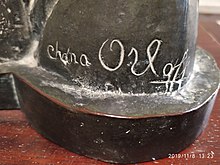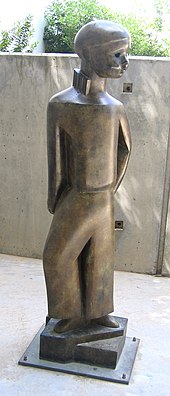
Chana Orloff (Hebrew: חנה אורלוף; 12 July 1888 – 16 December 1968) was a Ukrainian-born French and Israeli Art deco and figurative art sculptor.

Biography

Chana Orloff was born the eighth of nine children in a village called Kamenka, also known by the name of Tsaraconstantinovka, Russian Empire (now Ukraine). It was an agricultural colony in the Kherson district, Alexandrovesk county, Ekaterinoslav (Dnepropetrovskaya) province in southeastern Ukraine, on the coast of the Sea of Azov, part of the Black Sea. The largest nearby city was Mariupol, the second largest port city after Odessa in the Southern Russian Empire. As a teenager she took classes in sewing and dressmaking in Mariupol to ensure she could earn a living and avoid an arranged marriage.
In order to escape the pogroms in this period in Ukraine, Orloff immigrated with her family to Ottoman Palestine in 1905 and settled in Petah Tikva (Gateway of Hope), the first Jewish agricultural settlement in Palestine. She worked as a seamstress designing and sewing European-style clothing for local Jewish settlers. Eventually she moved away from her family and rented a room of her own in the Neve Tzedek neighborhood of Jaffa, to be closer to her clients. Zvi Nishri (Orloff), the pioneer in physical education in Israel, was her brother. Orloff took class at the Gymnasia Herzliya, where Nishri was a teacher, and joined the Hapoel Hatzair workers movement and Hapoel Rishon LeZion sports club. After five years in Palestine, she was offered a teaching position in sewing and dressmaking at Hovevei Zion School for Girls in Jaffa. Orloff went to Paris to study fashion with the expectation she would return to Palestine to begin her teaching position. In Paris she took classes in drawing and fashion design and worked at the haute couture house of Paquin. In 1911 she matriculated at the École nationale supérieure des arts décoratifs in hopes of pursuing a career in fine art. She enrolled simultaneously in informal classes at the Académie Russe in Montparnasse. In 1916, she married Ary Justman, a Warsaw-born Jewish writer and poet. The couple had a son in 1918, but Justman died of influenza in the epidemic of 1919. When the Nazis invaded Paris, Orloff fled to Switzerland with her son and the Jewish painter Georges Kars. In February 1945, Kars committed suicide in Geneva, after which Orloff returned to Paris, to find that her house had been ransacked and the sculptures in her studio destroyed.
Art career

In Paris, Orloff became friendly with other young Jewish artists, among them Marc Chagall, Jacques Lipchitz, Amedeo Modigliani, Jules Pascin, Chaïm Soutine, and Ossip Zadkine. In 1913, she exhibited in the Salon d'Automne. After the establishment of the State of Israel, Orloff began spending an increasing amount of time there. The Tel Aviv Museum of Art held an exhibition of 37 of her sculptures in 1949. She remained in Israel for about a year in order to complete a sculpture of David Ben-Gurion, The Hero Monument to the defenders of Ein Gev and The Motherhood Monument in memory of Chana Tuchman Alderstein who died during the 1947–1949 Palestine war. After her return to Paris in 1950, Orloff received support and friendship from the Ukrainian-born artist Norman Carton to further grow her Parisian career using photography. She became a mentor to him. In addition to monuments, Orloff sculpted portraits of Israeli Prime Minister David Ben-Gurion and future Prime Minister Levi Eshkol; the architects Pierre Chareau, and Auguste Perret; painters Henri Matisse, Amedeo Modigliani, Pablo Picasso, and Per Krohg; and the poets Hayyim Nahman Bialik, and Pierre Mac Orlan. .
Orloff died in Israel on 16 December 1968.
See also
References
- See Rokhel Luban (1898-1979), Memoirs, no date; translated from Yiddish by Chaim Freedman, http://kehilalinks.jewishgen.org/colonies_of_ukraine/memoirs_of_rokhel_luban.htm. Luban was born in 1889 in the neighboring Jewish colony of Trudolyubovka, which was also known to the Jews as Engels. In her memoir, Luban states that there were 17 colonies in Yekaterinoslav, and that the names of the town Tsaraconstantinovka and Kamenka were in fact interchangeable. Kamenka was established as a Jewish agricultural colony of Kherson Guberniya in 1808: http://evkol.ucoz.com/colony_kherson_en.htm.
- ^ Birnbaum, Paula (2023). Sculpting a Life: Chana Orloff Between Paris and Tel Aviv. Waltham, MA: Brandeis University Press. ISBN 978-1684581139.
- Raful Eitan (1992). A Soldier's Story: The Life and Times of an Israeli War Hero. SP Books. ISBN 1-56171-094-6. Retrieved 3 November 2011.
- Hersh Fenster, Undzere Farpainikte Kinstler, Paris, 1951, p. 200
- Birnbaum, Paula J. (2015) 'Chana Orloff', in Journal of Modern Jewish Studies, 1: 23, Routledge 2015/12/21. doi:10.1080/14725886.2015.1120430
Further reading
- Birnbaum, Paula J. Sculpting a Life: Chana Orloff Between Paris and Tel Aviv, Brandeis University Press, 2023.
- Birnbaum, Paula J. Women Artists in Interwar France: Framing Femininities, Aldershot, Ashgate, 2011.
- Kikoïne, Yankel, Chana Orloff, Paris, Musée Bourdelle, 1988, ISBN 2-901784-12-7.
- Kofler, Hana, Chana Orloff: Line & Substance, 1912-1968. Tefen: the Open Museum, Tefen Industrial Park, 1993.
- Marcilhac, Félix. Chana Orloff, Paris: Editions de l’Amateur, 1991.
- Musée Rodin, Chana Orloff; sculptures et dessins, Paris, Musée Rodin, 1971,
- Richard de la Fuente, Véronique, Dada à Barcelone, 1914-1918: Chronique de l'avant-garde artistique parisienne en exil en Catalogne pendant la grande guerre: Francis Picabia, Manolo Hugue, Serge Charchoune, Marie Laurencin, Olga Sacharoff, Franck Burty, Chana Orloff, Albert Gleizes, Kees van Dongen, Arthur Cravan, Otto Lloyd, Pau Gargallo, S et R Delaunay, Céret, Albères, 2001, ISBN 2-9517196-0-4.
- The Tel Aviv Museum, Chana Orloff: Exposition Retrospective, 120 Sculptures, 60 Designs, Tel Aviv Museum, 1969.
External links
- Biography in the Encyclopedia of Jewish Women at the Jewish Women's Archive
- Chana Orloff in American public collections, on the French Sculpture Census website

- Official web site Archived 27 February 2022 at the Wayback Machine
- "Chana Orloff". Information Center for Israeli Art. Israel Museum. Retrieved 1 February 2012.
- Chana Orloff collection at the Israel Museum. Retrieved February 2012.
- 1888 births
- 1968 deaths
- 20th-century sculptors
- 20th-century Israeli women artists
- Jewish sculptors
- Israeli sculptors
- Emigrants from the Russian Empire to the Ottoman Empire
- Jewish Israeli artists
- Ukrainian Jews
- People from Kostiantynivka
- People from Yekaterinoslav Governorate
- Ukrainian women sculptors
- Israeli women sculptors
- Burials at Kiryat Shaul Cemetery